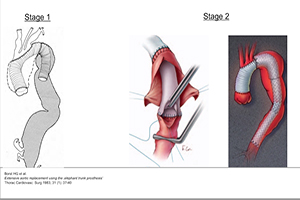Open total arch replacement with trifurcated graft and frozen elephant trunk
Abstract
Background: The frozen elephant trunk (FET) technique was introduced in Hannover Medical School in 2001 to treat patients with complex aortic arch pathologies. Since 2012, we primarily use the trifurcated Thoraflex Hybrid FET graft. In this article, we report our experience with the trifurcated FET graft.
Methods: Between November 2012 and September 2018, 211 patients underwent FET implantation with the trifurcated Vascutek Thoraflex Hybrid graft. The indications for surgery were: degenerative aneurysms in 68 patients, acute aortic dissections (AD) in 96 patients, and chronic ADs in 47 patients. And, 18% of cases were sternal re-operations.
Results: Mean cardiopulmonary bypass time, aortic cross-clamp time, and myocardial ischemia time were 262±84, 115±71, 50±26 minutes, respectively. Incidence of re-thoracotomy for bleeding, stroke, permanent paraplegia/paraparesis, prolonged ventilatory support (>96 h), and long-term dialysis were 13%, 18%, 2%, 21%, and 5%, respectively. In-hospital mortality was 12%. Follow-up was complete for 100% of patients and comprised a total of 513 patient years. The mean follow-up time was 2.2 [0–6] years. During follow-up, there were 32 aortic re-interventions distal to the FET. The survival rate at 1 and 5 years was 84% and 81%, respectively.
Conclusions: Total aortic arch replacements with trifurcated FET can be performed with positive results. The trifurcated graft allows selective anastomosis of the supra-aortic vessels, which might result in improved hemostasis.
Cover






